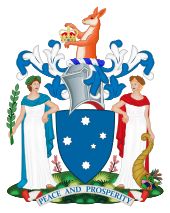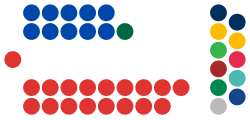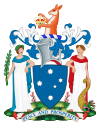Victorian Legislative Council
| Legislative Council | |
|---|---|
| 58th Parliament | |
 | |
| Type | |
| Type | Upper house of the Parliament of Victoria |
| History | |
| Founded | 1851 |
| Leadership | |
President | Bruce Atkinson, Liberal Since 21 December 2010 |
Deputy President | Gayle Tierney, Labor Since 23 December 2014 |
Leader of the Council | Gavin Jennings, Labor Since 23 December 2014 |
Leader of the Opposition | Mary Wooldridge, Liberal Since 17 December 2014 |
Government Whip | Cesar Melhem, Labor Since 23 December 2014 |
Opposition Whip | Wendy Lovell, Liberal Since 23 December 2014 |
| Structure | |
| Seats | 40 |
 | |
Political groups | Government (14) Labor (14) Opposition (16) Liberal (14) National (2) Crossbench (10) Greens (5) Shooters, Fishers, Farmers (2) Reason (1) Local Jobs (1) Independent (1) |
| Committees | Standing Committees
Domestic Committees
|
| Elections | |
Voting system | Single transferable vote with group voting tickets |
Last election | 24 November 2018 |
Next election | 26 November 2022 |
| Meeting place | |
 | |
| Legislative Council Chamber, Parliament House, Melbourne, Victoria, Australia | |
| Website | |
| Vic Legislative Council | |
The Victorian Legislative Council (VLC) is the upper house of the bicameral Parliament of Victoria, Australia; the lower house being the Legislative Assembly. Both houses sit at Parliament House in Spring Street, Melbourne. The Legislative Council serves as a house of review, in a similar fashion to its federal counterpart, the Australian Senate. Although it is possible for legislation to be first introduced in the Council, most bills receive their first hearing in the Legislative Assembly.
The presiding officer of the council is the President of the Legislative Council. The council presently has 40 members serving four-year terms, elected from eight electoral regions each with five members. With each region electing 5 members, the quota in each region for election, after distribution of preferences, is 16.7% (one-sixth).
Contents
1 History
1.1 First Legislative Council
1.2 Second Legislative Council
1.3 2003 reforms
2 Composition
3 Current distribution of seats
4 See also
5 Notes
6 External links
History
First Legislative Council

VLC electoral districts, 1851–1854
The separate colony of Victoria was proclaimed on 1 July 1851 and writs for the election of the first Legislative Council were issued at the same time for the 20 elected members.[1] The Legislative Council initially consisted of 30 members, 10 of which were nominated by the Lieutenant-Governor and 20 were elected from 16 "electoral districts", with Melbourne electing 3 members, and Geelong and the county of Bourke electing 2 members each.[2] The electors were male British subjects over the age of 21 years, who owned freehold valued at £100 or a householder paying rent of £10 per year,[2] both very large sums at the time. Members of the Legislative Council were unpaid, further restricting participation of those without independent means. It took some time before the Legislative Council was elected and ready to sit.[3] The Legislative Council met for the first time in November 1851 at St Patrick's Hall, which had been built in 1847 in Bourke Street, Melbourne.[4] The Legislative Council sat there until the opening of the Parliament House in 1856. James Frederick Palmer was the presiding officer of the Council, then called speaker.
The Legislative Council was expanded in 1853 to 18 nominees and 36 elected members.[5] A further expansion of the Council occurred in 1855, when 8 new members were elected from five new electorates, with one new nominee.[6][7]
The first Legislative Council existed for five years and was responsible for at least three significant and enduring contributions to the parliamentary system of Victoria:
- it drafted the Constitution of Victoria, which provides the framework for the system of government in Victoria;
- it introduced the secret ballot. The Victorian Electoral Act 1856 introduced secret ballots on 19 March 1856,[8] an innovation at the time but now common around the world; and
- it ordered the construction of the Victorian Parliament House in Melbourne.
The new constitution was approved by the Legislative Council in March 1854 and was sent to Britain where it was passed by the United Kingdom Parliament as the Victoria Constitution Act 1855, received Royal Assent on 16 July 1855 and was proclaimed in Victoria on 23 November 1855.[9][10] The Constitution established a Westminster-style system of responsible government that continues in Victoria today.[11]
Second Legislative Council

VLC electoral provinces, 1856–1882
The new Constitution came into effect in 1856. It created a bicameral Parliament of Victoria, with the Legislative Assembly being the lower house and the Council being the upper house. The Council consisted of 30 members, with 5 members being elected from each of the 6 provinces.[12] The Parliament of Victoria first met on 21 November 1856 at the almost completed main sections of Parliament House. James Frederick Palmer was elected first President of the Council.
The Legislative Council was later elected from a varying number of provinces. In 1882 several new provinces were created while Central and Eastern were abolished.[13] In 1904 more provinces were created[14] and two members (MLCs) represented each province. The terms for members were two Assembly terms, and one member was elected in rotation at each election, by majority-preferential (AV) vote. Until 1950 the Legislative Council was elected on a restricted property-based franchise and always had a conservative majority.
Until 1958, elections for the Legislative Council were not held in conjunction with those for the Legislative Assembly; and starting at the 1961 election they have been held at the same time. Prior to the 2006 election, the Legislative Council consisted of 44 members elected for two terms of the Legislative Assembly from 22 two-member provinces. Half the members were elected at each election on a rotation basis. This old system tended to favour the Liberal Party and the National Party (often in Coalition) over the Labor Party and other parties.[citation needed] This resulted in many instances of a Labor government being faced with an opposition-controlled Council — a rare occurrence elsewhere in Australia.
2003 reforms

The current eight regions of the Legislative Council.
The system changed for the 2006 Victorian election, as a result of major reforms passed by the Labor government, led by Steve Bracks, in 2003.[15] Under the new system the State is divided into eight regions each of which returns five members, who serve terms linked to the Legislative Assembly, which has fixed four-year terms unless earlier dissolved in exceptional circumstances.
Each region consists of 11 contiguous Legislative Assembly electoral districts with about 420,000 electors. Five regions are metropolitan (Eastern Metropolitan, Northern Metropolitan, South Eastern Metropolitan, Southern Metropolitan, and Western Metropolitan) and three are non-urban regions (Eastern Victoria, Northern Victoria and Western Victoria).
Since 2006 members have been elected using the single transferable vote system of proportional representation, making it easier for minor parties to gain election and possibly gain the balance of power, as opposed to majority control by a single major party.
At the same time, the Council's ability to block supply was removed.
Composition
Today the Council has 40 members serving four-year terms, elected from 8 electoral regions, with 5 members representing each region.
Current distribution of seats
The state of the parties in the Council as a result of the 2014 Victorian state election[16] is as follows:
| Party | Seats held | Percentage of Council | ||
|---|---|---|---|---|
| | Labor Party | 14 | 35.0% | |
| | Liberal Party | 14 | 35.0% | |
| | Greens | 5 | 12.5% | |
| | National Party | 2 | 5.0% | |
| | Shooters, Fishers and Farmers Party | 2 | 5.0% | |
| | Reason Party | 1 | 2.5% | |
| | Independent | 1 | 2.5% | |
| | Vote 1 Local Jobs | 1 | 2.5% | |
Total | 40 | 100.0% | ||
| Legislative Council seats by region | ||||||||||||||||||||
|---|---|---|---|---|---|---|---|---|---|---|---|---|---|---|---|---|---|---|---|---|
Eastern Metropolitan Region | | | | | | |||||||||||||||
Northern Metropolitan Region | | | | | | |||||||||||||||
South Eastern Metropolitan Region | | | | | | |||||||||||||||
Southern Metropolitan Region | | | | | | |||||||||||||||
Western Metropolitan Region | | | | | | |||||||||||||||
Eastern Victoria Region | | | | | | |||||||||||||||
Northern Victoria Region | | | | | | |||||||||||||||
Western Victoria Region | | | | | | |||||||||||||||
- 21 votes as a majority are required to pass legislation.
See also
- Victorian state election, 2018
Notes
^ "Anniversary of the Week". The Argus (Melbourne, Vic. : 1848 – 1956). Melbourne, Vic.: National Library of Australia. 4 July 1930. p. 2 Supplement: Saturday Camera Supplement. Retrieved 26 January 2012..mw-parser-output cite.citation{font-style:inherit}.mw-parser-output q{quotes:"""""""'""'"}.mw-parser-output code.cs1-code{color:inherit;background:inherit;border:inherit;padding:inherit}.mw-parser-output .cs1-lock-free a{background:url("//upload.wikimedia.org/wikipedia/commons/thumb/6/65/Lock-green.svg/9px-Lock-green.svg.png")no-repeat;background-position:right .1em center}.mw-parser-output .cs1-lock-limited a,.mw-parser-output .cs1-lock-registration a{background:url("//upload.wikimedia.org/wikipedia/commons/thumb/d/d6/Lock-gray-alt-2.svg/9px-Lock-gray-alt-2.svg.png")no-repeat;background-position:right .1em center}.mw-parser-output .cs1-lock-subscription a{background:url("//upload.wikimedia.org/wikipedia/commons/thumb/a/aa/Lock-red-alt-2.svg/9px-Lock-red-alt-2.svg.png")no-repeat;background-position:right .1em center}.mw-parser-output .cs1-subscription,.mw-parser-output .cs1-registration{color:#555}.mw-parser-output .cs1-subscription span,.mw-parser-output .cs1-registration span{border-bottom:1px dotted;cursor:help}.mw-parser-output .cs1-hidden-error{display:none;font-size:100%}.mw-parser-output .cs1-visible-error{font-size:100%}.mw-parser-output .cs1-subscription,.mw-parser-output .cs1-registration,.mw-parser-output .cs1-format{font-size:95%}.mw-parser-output .cs1-kern-left,.mw-parser-output .cs1-kern-wl-left{padding-left:0.2em}.mw-parser-output .cs1-kern-right,.mw-parser-output .cs1-kern-wl-right{padding-right:0.2em}
^ ab "Victorian Electoral Act" (PDF). New South Wales Government. 1851. Retrieved 30 July 2014.
^ A City Lost and Found
^ Australian Dictionary of Biography: Jackson, Samuel (1807–1876)
^ Sweetman, p.108
^ Sweetman, p.110
^ "An Act to further alter "The Victoria Electoral Act of 1851" and to increase the Number of Members of the Legislative Council of Victoria" (PDF). 1855. Retrieved 5 June 2013.
^ Payment of Members Act 1870 (Vic)
^
"Victoria Constitution Act 1855" (PDF). Retrieved 5 May 2013.
^ "Altering Victoria's Constitution". Fact Sheet D3: Altering Victoria's Constitution. Parliament of Victoria. October 2010. Retrieved 5 March 2011.
^ "Victoria Constitution Act 1855". An Act to enable Her Majesty to assent to a Bill, as amended, of the Legislature of Victoria, to establish a Constitution in and for the Colony of Victoria. Parliament of the United Kingdom. 1855. Archived from the original on 12 March 2011. Retrieved 5 March 2011.
^ Edward Sweetman (1920). Constitutional Development of Victoria, 1851-6. Whitcombe & Tombs Limited. p. 183. Retrieved 5 June 2013.
^ Victoria Parliamentary Debates (Hansard), Session 1882 (PDF). 41. Melb.: John Ferres. 1883. p. 2670.
^ Victoria Parliamentary Debates (Hansard), Session 1904 (PDF). 107. Melb.: R. S. Brain. 1905.
^ Constitution (Parliamentary Reform) Act 2003
^ 2014 Victorian state election results
External links
- Legislative Council - Parliament of Victoria

